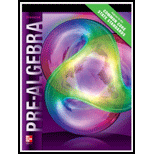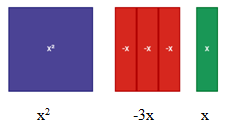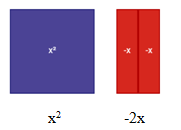
Pre-Algebra Student Edition
1st Edition
ISBN: 9780078957734
Author: Glencoe/McGraw-Hill
Publisher: MCG
expand_more
expand_more
format_list_bulleted
Concept explainers
Question
Chapter 14.1, Problem 4CYU
To determine
Simplify each polynomial
Expert Solution & Answer
Explanation of Solution
Given information:
Here, x2 is represented using 1blue algebra tile and -3x is represented using 3 red tiles and x is represented using 1 green tile.

Solving,

Chapter 14 Solutions
Pre-Algebra Student Edition
Ch. 14.1 - Prob. 1AGPCh. 14.1 - Prob. 1BGPCh. 14.1 - Prob. 2AGPCh. 14.1 - Prob. 2BGPCh. 14.1 - Prob. 3AGPCh. 14.1 - Prob. 3BGPCh. 14.1 - Prob. 4GPCh. 14.1 - Prob. 1CYUCh. 14.1 - Prob. 2CYUCh. 14.1 - Prob. 3CYU
Ch. 14.1 - Prob. 4CYUCh. 14.1 - Prob. 5CYUCh. 14.1 - Prob. 6CYUCh. 14.1 - Prob. 7CYUCh. 14.1 - Prob. 8CYUCh. 14.1 - Prob. 9CYUCh. 14.1 - Prob. 10PPSCh. 14.1 - Prob. 11PPSCh. 14.1 - Prob. 12PPSCh. 14.1 - Prob. 13PPSCh. 14.1 - Prob. 14PPSCh. 14.1 - Prob. 15PPSCh. 14.1 - Prob. 16PPSCh. 14.1 - Prob. 17PPSCh. 14.1 - Prob. 18PPSCh. 14.1 - Prob. 19PPSCh. 14.1 - Prob. 20PPSCh. 14.1 - Prob. 21PPSCh. 14.1 - Prob. 22PPSCh. 14.1 - Prob. 23PPSCh. 14.1 - Prob. 24PPSCh. 14.1 - Prob. 25PPSCh. 14.1 - Prob. 26PPSCh. 14.1 - Prob. 27PPSCh. 14.1 - Prob. 28PPSCh. 14.1 - Prob. 29PPSCh. 14.1 - Prob. 30PPSCh. 14.1 - Prob. 31PPSCh. 14.1 - Prob. 32PPSCh. 14.1 - Prob. 33PPSCh. 14.1 - Prob. 34HPCh. 14.1 - Prob. 35HPCh. 14.1 - Prob. 36HPCh. 14.1 - Prob. 37HPCh. 14.2 - Prob. 1AGPCh. 14.2 - Prob. 1BGPCh. 14.2 - Prob. 2AGPCh. 14.2 - Prob. 2BGPCh. 14.2 - Prob. 3GPCh. 14.2 - Prob. 1CYUCh. 14.2 - Prob. 2CYUCh. 14.2 - Prob. 3CYUCh. 14.2 - Prob. 4CYUCh. 14.2 - Prob. 5CYUCh. 14.2 - Prob. 6PPSCh. 14.2 - Prob. 7PPSCh. 14.2 - Prob. 8PPSCh. 14.2 - Prob. 9PPSCh. 14.2 - Prob. 10PPSCh. 14.2 - Prob. 11PPSCh. 14.2 - Prob. 12PPSCh. 14.2 - Prob. 13PPSCh. 14.2 - Prob. 14PPSCh. 14.2 - Prob. 15PPSCh. 14.2 - Prob. 16PPSCh. 14.2 - Prob. 17PPSCh. 14.2 - Prob. 18HPCh. 14.2 - Prob. 19HPCh. 14.2 - Prob. 20HPCh. 14.2 - Prob. 21HPCh. 14.3 - Prob. 1AGPCh. 14.3 - Prob. 1BGPCh. 14.3 - Prob. 2GPCh. 14.3 - Prob. 3GPCh. 14.3 - Prob. 1CYUCh. 14.3 - Prob. 2CYUCh. 14.3 - Prob. 3CYUCh. 14.3 - Prob. 4CYUCh. 14.3 - Prob. 5CYUCh. 14.3 - Prob. 6PPSCh. 14.3 - Prob. 7PPSCh. 14.3 - Prob. 8PPSCh. 14.3 - Prob. 9PPSCh. 14.3 - Prob. 10PPSCh. 14.3 - Prob. 11PPSCh. 14.3 - Prob. 12PPSCh. 14.3 - Prob. 13PPSCh. 14.3 - Prob. 14PPSCh. 14.3 - Prob. 15HPCh. 14.3 - Prob. 16HPCh. 14.3 - Prob. 17HPCh. 14.4 - Prob. 1CYUCh. 14.4 - Prob. 2CYUCh. 14.4 - Prob. 3CYUCh. 14.4 - Prob. 4CYUCh. 14.4 - Prob. 5CYUCh. 14.4 - Prob. 6CYUCh. 14.4 - Prob. 7CYUCh. 14.4 - Prob. 8CYUCh. 14.4 - Prob. 9CYUCh. 14.4 - Prob. 10CYUCh. 14.4 - Prob. 11CYUCh. 14.4 - Prob. 12PPSCh. 14.4 - Prob. 13PPSCh. 14.4 - Prob. 14PPSCh. 14.4 - Prob. 15PPSCh. 14.4 - Prob. 16PPSCh. 14.4 - Prob. 17PPSCh. 14.4 - Prob. 18PPSCh. 14.4 - Prob. 19PPSCh. 14.4 - Prob. 20PPSCh. 14.4 - Prob. 21PPSCh. 14.4 - Prob. 22PPSCh. 14.4 - Prob. 23PPSCh. 14.4 - Prob. 24PPSCh. 14.4 - Prob. 25PPSCh. 14.4 - Prob. 26PPSCh. 14.4 - Prob. 27PPSCh. 14.4 - Prob. 28PPSCh. 14.4 - Prob. 29PPSCh. 14.4 - Prob. 30HPCh. 14.4 - Prob. 31HPCh. 14.4 - Prob. 32HPCh. 14.4 - Prob. 33HPCh. 14.4 - Prob. 34HPCh. 14.5 - Prob. 1AGPCh. 14.5 - Prob. 1BGPCh. 14.5 - Prob. 2AGPCh. 14.5 - Prob. 2BGPCh. 14.5 - Prob. 3GPCh. 14.5 - Prob. 1CYUCh. 14.5 - Prob. 2CYUCh. 14.5 - Prob. 3CYUCh. 14.5 - Prob. 4CYUCh. 14.5 - Prob. 5CYUCh. 14.5 - Prob. 6CYUCh. 14.5 - Prob. 7CYUCh. 14.5 - Prob. 8CYUCh. 14.5 - Prob. 9CYUCh. 14.5 - Prob. 10CYUCh. 14.5 - Prob. 11PPSCh. 14.5 - Prob. 12PPSCh. 14.5 - Prob. 13PPSCh. 14.5 - Prob. 14PPSCh. 14.5 - Prob. 15PPSCh. 14.5 - Prob. 16PPSCh. 14.5 - Prob. 17PPSCh. 14.5 - Prob. 18PPSCh. 14.5 - Prob. 19PPSCh. 14.5 - Prob. 20PPSCh. 14.5 - Prob. 21PPSCh. 14.5 - Prob. 22PPSCh. 14.5 - Prob. 23PPSCh. 14.5 - Prob. 24PPSCh. 14.5 - Prob. 25PPSCh. 14.5 - Prob. 26PPSCh. 14.5 - Prob. 27PPSCh. 14.5 - Prob. 28PPSCh. 14.5 - Prob. 29PPSCh. 14.5 - Prob. 30PPSCh. 14.5 - Prob. 31PPSCh. 14.5 - Prob. 32PPSCh. 14.5 - Prob. 33PPSCh. 14.5 - Prob. 34PPSCh. 14.5 - Prob. 35PPSCh. 14.5 - Prob. 36PPSCh. 14.5 - Prob. 37HPCh. 14.5 - Prob. 38HPCh. 14.5 - Prob. 39HPCh. 14.5 - Prob. 40HPCh. 14.6 - Prob. 1AGPCh. 14.6 - Prob. 1BGPCh. 14.6 - Prob. 2GPCh. 14.6 - Prob. 1CYUCh. 14.6 - Prob. 2CYUCh. 14.6 - Prob. 3CYUCh. 14.6 - Prob. 4CYUCh. 14.6 - Prob. 5CYUCh. 14.6 - Prob. 6CYUCh. 14.6 - Prob. 7CYUCh. 14.6 - Prob. 8CYUCh. 14.6 - Prob. 9CYUCh. 14.6 - Prob. 10CYUCh. 14.6 - Prob. 11CYUCh. 14.6 - Prob. 12CYUCh. 14.6 - Prob. 13PPSCh. 14.6 - Prob. 14PPSCh. 14.6 - Prob. 15PPSCh. 14.6 - Prob. 16PPSCh. 14.6 - Prob. 17PPSCh. 14.6 - Prob. 18PPSCh. 14.6 - Prob. 19PPSCh. 14.6 - Prob. 20PPSCh. 14.6 - Prob. 21PPSCh. 14.6 - Prob. 22PPSCh. 14.6 - Prob. 23HPCh. 14.6 - Prob. 24HPCh. 14.6 - Prob. 25HPCh. 14.6 - Prob. 26HPCh. 14.6 - Prob. 27HPCh. 14.7 - Prob. 1AGPCh. 14.7 - Prob. 1BGPCh. 14.7 - Prob. 1CGPCh. 14.7 - Prob. 1DGPCh. 14.7 - Prob. 2AGPCh. 14.7 - Prob. 2BGPCh. 14.7 - Prob. 3GPCh. 14.7 - Prob. 1CYUCh. 14.7 - Prob. 2CYUCh. 14.7 - Prob. 3CYUCh. 14.7 - Prob. 4CYUCh. 14.7 - Prob. 5CYUCh. 14.7 - Prob. 6CYUCh. 14.7 - Prob. 7CYUCh. 14.7 - Prob. 8PPSCh. 14.7 - Prob. 9PPSCh. 14.7 - Prob. 10PPSCh. 14.7 - Prob. 11PPSCh. 14.7 - Prob. 12PPSCh. 14.7 - Prob. 13PPSCh. 14.7 - Prob. 14PPSCh. 14.7 - Prob. 15PPSCh. 14.7 - Prob. 16HPCh. 14.7 - Prob. 17HPCh. 14.7 - Prob. 18HPCh. 14.7 - Prob. 19HPCh. 14.8 - Prob. 1AGPCh. 14.8 - Prob. 1BGPCh. 14.8 - Prob. 2AGPCh. 14.8 - Prob. 2BGPCh. 14.8 - Prob. 3GPCh. 14.8 - Prob. 1CYUCh. 14.8 - Prob. 2CYUCh. 14.8 - Prob. 3CYUCh. 14.8 - Prob. 4CYUCh. 14.8 - Prob. 5CYUCh. 14.8 - Prob. 6CYUCh. 14.8 - Prob. 7CYUCh. 14.8 - Prob. 8PPSCh. 14.8 - Prob. 9PPSCh. 14.8 - Prob. 10PPSCh. 14.8 - Prob. 11PPSCh. 14.8 - Prob. 12PPSCh. 14.8 - Prob. 13PPSCh. 14.8 - Prob. 14PPSCh. 14.8 - Prob. 15PPSCh. 14.8 - Prob. 16PPSCh. 14.8 - Prob. 17PPSCh. 14.8 - Prob. 18PPSCh. 14.8 - Prob. 19PPSCh. 14.8 - Prob. 20HPCh. 14.8 - Prob. 21HPCh. 14.8 - Prob. 22HPCh. 14.8 - Prob. 23HPCh. 14 - Prob. 1SGRCh. 14 - Prob. 2SGRCh. 14 - Prob. 3SGRCh. 14 - Prob. 4SGRCh. 14 - Prob. 5SGRCh. 14 - Prob. 6SGRCh. 14 - Prob. 7SGRCh. 14 - Prob. 8SGRCh. 14 - Prob. 9SGRCh. 14 - Prob. 10SGRCh. 14 - Prob. 11SGRCh. 14 - Prob. 12SGRCh. 14 - Prob. 13SGRCh. 14 - Prob. 14SGRCh. 14 - Prob. 15SGRCh. 14 - Prob. 16SGRCh. 14 - Prob. 17SGRCh. 14 - Prob. 18SGRCh. 14 - Prob. 19SGRCh. 14 - Prob. 20SGRCh. 14 - Prob. 21SGRCh. 14 - Prob. 22SGRCh. 14 - Prob. 23SGRCh. 14 - Prob. 24SGRCh. 14 - Prob. 25SGRCh. 14 - Prob. 26SGRCh. 14 - Prob. 27SGRCh. 14 - Prob. 28SGRCh. 14 - Prob. 29SGRCh. 14 - Prob. 30SGRCh. 14 - Prob. 31SGRCh. 14 - Prob. 32SGRCh. 14 - Prob. 33SGRCh. 14 - Prob. 34SGRCh. 14 - Prob. 35SGRCh. 14 - Prob. 36SGRCh. 14 - Prob. 37SGRCh. 14 - Prob. 38SGRCh. 14 - Prob. 39SGRCh. 14 - Prob. 40SGRCh. 14 - Prob. 41SGRCh. 14 - Prob. 42SGRCh. 14 - Prob. 43SGRCh. 14 - Prob. 44SGRCh. 14 - Prob. 45SGRCh. 14 - Prob. 46SGRCh. 14 - Prob. 47SGRCh. 14 - Prob. 48SGRCh. 14 - Prob. 49SGRCh. 14 - Prob. 50SGRCh. 14 - Prob. 51SGRCh. 14 - Prob. 52SGRCh. 14 - Prob. 53SGRCh. 14 - Prob. 54SGRCh. 14 - Prob. 55SGRCh. 14 - Prob. 56SGRCh. 14 - Prob. 1PTCh. 14 - Prob. 2PTCh. 14 - Prob. 3PTCh. 14 - Prob. 4PTCh. 14 - Prob. 5PTCh. 14 - Prob. 6PTCh. 14 - Prob. 7PTCh. 14 - Prob. 8PTCh. 14 - Prob. 9PTCh. 14 - Prob. 10PTCh. 14 - Prob. 11PTCh. 14 - Prob. 12PTCh. 14 - Prob. 13PTCh. 14 - Prob. 14PTCh. 14 - Prob. 15PTCh. 14 - Prob. 16PTCh. 14 - Prob. 17PTCh. 14 - Prob. 18PTCh. 14 - Prob. 19PTCh. 14 - Prob. 20PTCh. 14 - Prob. 21PTCh. 14 - Prob. 22PTCh. 14 - Prob. 23PTCh. 14 - Prob. 24PTCh. 14 - Prob. 25PTCh. 14 - Prob. 26PTCh. 14 - Prob. 27PTCh. 14 - Prob. 28PTCh. 14 - Prob. 29PTCh. 14 - Prob. 30PTCh. 14 - Prob. 31PTCh. 14 - Prob. 32PTCh. 14 - Prob. 33PTCh. 14 - Prob. 34PTCh. 14 - Prob. 35PTCh. 14 - Prob. 36PT
Additional Math Textbook Solutions
Find more solutions based on key concepts
CHECK POINT 1 In a survey on musical tastes, respondents were asked: Do you listed to classical music? Do you l...
Thinking Mathematically (6th Edition)
Applying the Empirical Rule with z-Scores The Empirical Rule applies rough approximations to probabilities for ...
Introductory Statistics
Two symmetric dice have had two of their sides painted red, two painted black, one painted yellow, and the othe...
A First Course in Probability (10th Edition)
In Exercises 17-20, find the volume of the solid generated by revolving the shaded region about the given axis....
University Calculus: Early Transcendentals (4th Edition)
1. combination of numbers, variables, and operation symbols is called an algebraic______.
Algebra and Trigonometry (6th Edition)
Knowledge Booster
Learn more about
Need a deep-dive on the concept behind this application? Look no further. Learn more about this topic, algebra and related others by exploring similar questions and additional content below.Similar questions
- Can you check if my step is correct?arrow_forwardI need help explaining on this example on how can I define the Time-Domain Function, Apply the Laplace Transformation Formula, and Simplify to Find the Frequency-Domain Expression. I need to understand on finding Y(s)arrow_forwardI need help explaining on this example on how can I define the Time-Domain Function, Apply the Laplace Transformation Formula, andarrow_forward
- ma Classes Term. Spring 2025 Title Details Credit Hours CRN Schedule Type Grade Mode Level Date Status Message *MATHEMATICS FOR MANAGEME... MTH 245, 400 4 54835 Online Normal Grading Mode Ecampus Undergradu... 03/21/2025 Registered **Web Registered... *SOIL SCIENCE CSS 205, 400 0 52298 Online Normal Grading Mode Undergraduate 03/21/2025 Waitlisted Waitlist03/21/2025 PLANT PATHOLOGY BOT 451, 400 4 56960 Online Normal Grading Mode Undergraduate 03/21/2025 Registered **Web Registered... Records: 3 Schedule Schedule Detailsarrow_forwardHere is an augmented matrix for a system of equations (three equations and three variables). Let the variables used be x, y, and z: 1 2 4 6 0 1 -1 3 0 0 1 4 Note: that this matrix is already in row echelon form. Your goal is to use this row echelon form to revert back to the equations that this represents, and then to ultimately solve the system of equations by finding x, y and z. Input your answer as a coordinate point: (x,y,z) with no spaces.arrow_forward1 3 -4 In the following matrix perform the operation 2R1 + R2 → R2. -2 -1 6 After you have completed this, what numeric value is in the a22 position?arrow_forward
- 5 -2 0 1 6 12 Let A = 6 7 -1 and B = 1/2 3 -14 -2 0 4 4 4 0 Compute -3A+2B and call the resulting matrix R. If rij represent the individual entries in the matrix R, what numeric value is in 131? Input your answer as a numeric value only.arrow_forward1 -2 4 10 My goal is to put the matrix 5 -1 1 0 into row echelon form using Gaussian elimination. 3 -2 6 9 My next step is to manipulate this matrix using elementary row operations to get a 0 in the a21 position. Which of the following operations would be the appropriate elementary row operation to use to get a 0 in the a21 position? O (1/5)*R2 --> R2 ○ 2R1 + R2 --> R2 ○ 5R1+ R2 --> R2 O-5R1 + R2 --> R2arrow_forwardThe 2x2 linear system of equations -2x+4y = 8 and 4x-3y = 9 was put into the following -2 4 8 augmented matrix: 4 -3 9 This augmented matrix is then converted to row echelon form. Which of the following matrices is the appropriate row echelon form for the given augmented matrix? 0 Option 1: 1 11 -2 Option 2: 4 -3 9 Option 3: 10 ܂ -2 -4 5 25 1 -2 -4 Option 4: 0 1 5 1 -2 Option 5: 0 0 20 -4 5 ○ Option 1 is the appropriate row echelon form. ○ Option 2 is the appropriate row echelon form. ○ Option 3 is the appropriate row echelon form. ○ Option 4 is the appropriate row echelon form. ○ Option 5 is the appropriate row echelon form.arrow_forward
- Let matrix A have order (dimension) 2x4 and let matrix B have order (dimension) 4x4. What results when you compute A+B? The resulting matrix will have dimensions of 2x4. ○ The resulting matrix will be a single number (scalar). The resulting matrix will have dimensions of 4x4. A+B is undefined since matrix A and B do not have the same dimensions.arrow_forwardIf -1 "[a446]-[254] 4b = -1 , find the values of a and b. ○ There is no solution for a and b. ○ There are infinite solutions for a and b. O a=3, b=3 O a=1, b=2 O a=2, b=1 O a=2, b=2arrow_forwardA student puts a 3x3 system of linear equations is into an augmented matrix. The student then correctly puts the augmented matrix into row echelon form (REF), which yields the following resultant matrix: -2 3 -0.5 10 0 0 0 -2 0 1 -4 Which of the following conclusions is mathematically supported by the work shown about system of linear equations? The 3x3 system of linear equations has no solution. ○ The 3x3 system of linear equations has infinite solutions. The 3x3 system of linear equations has one unique solution.arrow_forward
arrow_back_ios
SEE MORE QUESTIONS
arrow_forward_ios
Recommended textbooks for you
 Algebra and Trigonometry (6th Edition)AlgebraISBN:9780134463216Author:Robert F. BlitzerPublisher:PEARSON
Algebra and Trigonometry (6th Edition)AlgebraISBN:9780134463216Author:Robert F. BlitzerPublisher:PEARSON Contemporary Abstract AlgebraAlgebraISBN:9781305657960Author:Joseph GallianPublisher:Cengage Learning
Contemporary Abstract AlgebraAlgebraISBN:9781305657960Author:Joseph GallianPublisher:Cengage Learning Linear Algebra: A Modern IntroductionAlgebraISBN:9781285463247Author:David PoolePublisher:Cengage Learning
Linear Algebra: A Modern IntroductionAlgebraISBN:9781285463247Author:David PoolePublisher:Cengage Learning Algebra And Trigonometry (11th Edition)AlgebraISBN:9780135163078Author:Michael SullivanPublisher:PEARSON
Algebra And Trigonometry (11th Edition)AlgebraISBN:9780135163078Author:Michael SullivanPublisher:PEARSON Introduction to Linear Algebra, Fifth EditionAlgebraISBN:9780980232776Author:Gilbert StrangPublisher:Wellesley-Cambridge Press
Introduction to Linear Algebra, Fifth EditionAlgebraISBN:9780980232776Author:Gilbert StrangPublisher:Wellesley-Cambridge Press College Algebra (Collegiate Math)AlgebraISBN:9780077836344Author:Julie Miller, Donna GerkenPublisher:McGraw-Hill Education
College Algebra (Collegiate Math)AlgebraISBN:9780077836344Author:Julie Miller, Donna GerkenPublisher:McGraw-Hill Education

Algebra and Trigonometry (6th Edition)
Algebra
ISBN:9780134463216
Author:Robert F. Blitzer
Publisher:PEARSON

Contemporary Abstract Algebra
Algebra
ISBN:9781305657960
Author:Joseph Gallian
Publisher:Cengage Learning

Linear Algebra: A Modern Introduction
Algebra
ISBN:9781285463247
Author:David Poole
Publisher:Cengage Learning

Algebra And Trigonometry (11th Edition)
Algebra
ISBN:9780135163078
Author:Michael Sullivan
Publisher:PEARSON

Introduction to Linear Algebra, Fifth Edition
Algebra
ISBN:9780980232776
Author:Gilbert Strang
Publisher:Wellesley-Cambridge Press

College Algebra (Collegiate Math)
Algebra
ISBN:9780077836344
Author:Julie Miller, Donna Gerken
Publisher:McGraw-Hill Education
Polynomials with Trigonometric Solutions (2 of 3: Substitute & solve); Author: Eddie Woo;https://www.youtube.com/watch?v=EnfhYp4o20w;License: Standard YouTube License, CC-BY
Quick Revision of Polynomials | Tricks to Solve Polynomials in Algebra | Maths Tricks | Letstute; Author: Let'stute;https://www.youtube.com/watch?v=YmDnGcol-gs;License: Standard YouTube License, CC-BY
Introduction to Polynomials; Author: Professor Dave Explains;https://www.youtube.com/watch?v=nPPNgin7W7Y;License: Standard Youtube License